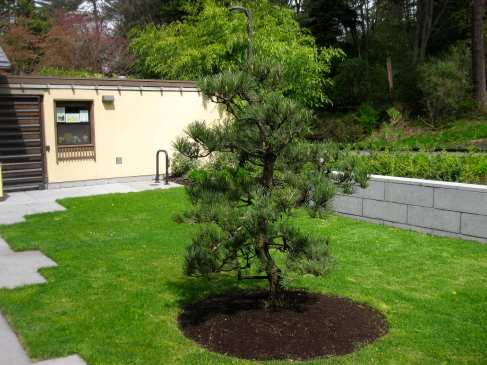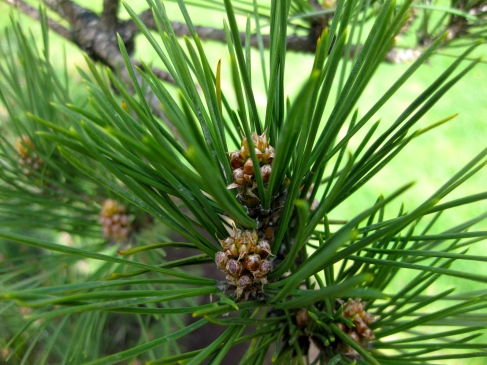Pine is a very important tree in Japanese Garden and we have many of them in SJG. Here is the one that you can see in the courtyard garden, before you even get to the ticket booth or inside:
From wikipedia: Pinus thunbergii (Syn: Pinus thunbergiana; English: Japanese Black Pine, Japanese Pine, Black Pine; Korean: 곰솔 ; Chinese: 黑松 ; Japanese: Kuromatsu; Kanji: 黒松) is a pine native to coastal areas of Japan (Kyūshū, Shikoku and Honshū, but not Hokkaidō) and South Korea. […]
From Floridata: Japanese black pine is a distinctive and picturesque evergreen with an open, irregular structure. The branches are large and contorted, horizontally spreading and sometimes pendulous. The foliage tends to be concentrated near the tips of the branchlets. Japanese black pine generally gets 20-30 ft (6-9 m) tall in cultivation, but can get over 100 ft (30.5 m) tall in its native habitat. Japanese black pine has fairly stiff dark green needles 3-5 in (7.6-12.7 cm) long in sheaths of two. It usually sports silvery white “candles” – young fast-growing upright shoots. The candles really stand out against the dark green foliage. Many cultivars have been selected, especially in Japan, and most are difficult to obtain in the U.S. ‘Thunderhead’ is compact, with dense foliage and stays under 10 ft (3 m) tall. The needles of ‘Oculus-draconis’ have yellow crossbands. ‘Iseli’ has needles edged with yellow. ‘Kotobuki’ is smaller with short needles. There are several dwarf cultivars selected for bonsai.
Location: Japanese black pine is native to northeastern China, Korea and Japan. It’s a popular landscape tree in Japan and in coastal gardens in northern Europe and the northeastern U.S. […]



